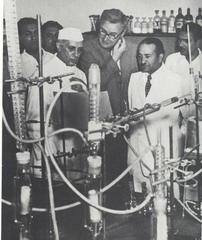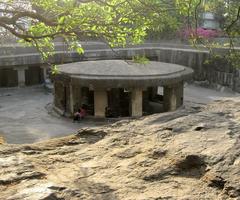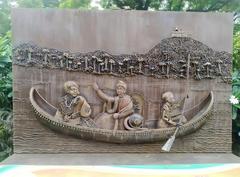Shrimant Bhausaheb Rangari Ganapati Temple, Pune: Visiting Hours, Tickets, and Historical Significance
Date: 03/07/2025
Introduction
Situated in Pune’s historic core, the Shrimant Bhausaheb Rangari Ganapati Temple is a landmark of spiritual devotion and a symbol of India’s social and political awakening. Established in 1892 under British colonial rule, it pioneered the first public—or “Sarvajanik”—Ganeshotsav in India. This transition from private worship to grand public celebration played a pivotal role in uniting communities, nurturing the spirit of resistance, and laying the foundation for the modern Ganeshotsav festival (The Better India; Pune Mirror).
The temple’s founder, Shrimant Bhausaheb Rangari—a royal physician and freedom fighter—crafted the temple’s Ganesh idol to depict the deity in a powerful warrior stance, slaying a demon. This iconography became a rallying symbol for justice and independence. Today, the temple remains a beacon of heritage, community, and inclusiveness, drawing devotees and cultural explorers alike (WorldOrgs).
This detailed guide covers the temple’s historical significance, visiting hours, ticket information, accessibility details, travel tips, and nearby attractions, ensuring a rich and informative experience for every visitor (Punekar News; My Pune Pulse).
Historical Overview
Origins and Socio-Political Context
The late 19th century saw Pune as a crucible of social and political transformation during British colonial rule. Shrimant Bhausaheb Rangari, collaborating with Krishnajipant Khasgiwale, initiated India’s first public Ganeshotsav here in 1892. Inspired by public Ganesh celebrations in Gwalior, they transformed Rangari Wada into a hub for both religious worship and political activism (The Positive Diary; Pune Ganpati Blogspot).
The First Public Ganeshotsav
The original idol, made from paper pulp, depicted Lord Ganesha defeating a demon—an allegory for resistance against colonial oppression. This symbolic act galvanized public sentiment and set a template for community-driven festivals that fostered social and political unity (The Better India; Pune Ganpati Blogspot).
Enduring Legacy
For over 130 years, the Shrimant Bhausaheb Rangari Ganapati Temple has hosted one of India’s oldest continuous public Ganeshotsav celebrations. The temple continues to inspire with its grand processions, animal-friendly rath (chariot), and vibrant cultural events (Punekar News).
The Temple: Architecture and Unique Features
Location and Layout
- Address: 662, 657 Bhau Rangari Road, Budhwar Peth, Pune, Maharashtra 411002, India (Google Maps).
- Housed within the traditional Rangari Wada, the temple displays classic late-19th-century Pune architecture: wooden beams, courtyards, and intricate latticework (WorldOrgs).
The Iconic Ganesh Idol
- Material: Crafted from wood and bran (sawdust), preserved since 1892 (Wikipedia; Pune Mirror).
- Iconography: Depicts Ganesha slaying a demon, symbolizing justice and freedom (Curly Tales).
The Wada: Living Museum
- The complex houses artifacts like period weapons and the original festival chariot, contextualizing the temple’s role in Pune’s independence movement (WorldOrgs).
Rituals, Festivals, and Community Engagement
Ganeshotsav Celebrations
- Ten-day festival with elaborate decorations, eco-friendly initiatives, and cultural performances (Pune Mirror).
- Daily aartis, dhol-tasha troupes, and bhajan groups create a festive atmosphere (Evendo).
- Prasad (sweets) distributed to all visitors.
Social Initiatives
- Health camps, educational programs, and women’s empowerment activities during Ganeshotsav (Punekar News).
- Special Atharvashirsha recitations for women and students; mass participation in social initiatives (My Pune Pulse).
- Reel competitions and cultural performances encourage youth involvement.
Heritage and Inclusivity
- The temple is a prominent stop on Pune’s heritage walks, and its inclusive ethos is reflected in its association with Guruji Talim Ganpati, founded by Hindu and Muslim families (Pune Mirror).
Visitor Information
Visiting Hours
- General: 6:00 AM to 9:00 PM daily.
- Ganeshotsav: Extended hours, typically until 10:30 PM.
Entry and Tickets
- Entry: Free for all visitors. No tickets required.
- Special Events: Some guided tours or programs may require prior registration; check with the temple trust.
Accessibility and Facilities
- Access: Wheelchair access and volunteer assistance available.
- Facilities: Restrooms, drinking water, seating areas, and nearby local eateries (Evendo).
- Transport: Close to Pune Junction; accessible by bus, auto-rickshaw, and on foot (Yappe). Limited parking; public transport recommended during festivals.
Photography
- Permitted in public areas. Please be respectful during rituals and aartis.
Guided Tours
- Offered during festival periods or by prior arrangement. Contact the temple trust for details.
Nearby Attractions
- Shaniwar Wada (2 km)
- Dagdusheth Halwai Ganapati Temple (3 km)
- Lal Mahal
- Pune Tribal Museum (4 km)
Key Ganeshotsav 2024 Highlights
- Grand opening procession and idol installation featuring cultural icons (freepressjournal.in).
- Daily rituals and aartis with mass participation.
- Health camps and educational programs open to all.
- Spectacular immersion procession (visarjan) on Anant Chaturdashi (mypunepulse.com).
FAQs
Q: What are the temple’s visiting hours?
A: 6:00 AM to 9:00 PM daily, with extended hours during Ganeshotsav.
Q: Is there an entry fee?
A: No, entry is free.
Q: Is the temple accessible to differently-abled visitors?
A: Yes, with ramps and assistance provided.
Q: Are guided tours available?
A: Yes, especially during festivals or by prior request.
Q: How do I reach the temple?
A: Centrally located, accessible by public transport and auto-rickshaw.
Q: What is the best time to visit?
A: During Ganeshotsav (August-September), or early morning/late evening for fewer crowds.
Conclusion
Shrimant Bhausaheb Rangari Ganapati Temple is a unique confluence of devotion, heritage, and social engagement. Its enduring legacy as the birthplace of the Sarvajanik Ganeshotsav and its ongoing commitment to inclusivity, cultural preservation, and community welfare make it an unmissable destination for pilgrims, tourists, and history enthusiasts. Plan your visit to experience Pune’s vibrant traditions, immerse in the Ganeshotsav festivities, and witness a living symbol of India’s collective spirit and resilience.
For updates, guided tours, and event schedules, follow the temple’s official social channels and download the Audiala app for an enhanced cultural experience.




